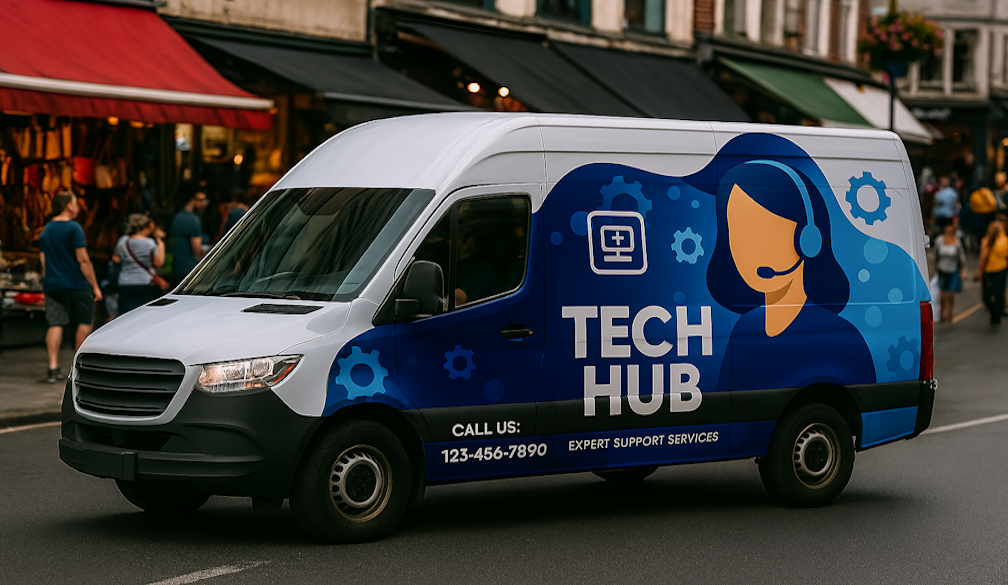Vehicle Signage and Truck Signage: Driving Brand Visibility on Every Road
- Written by Telegraph Magazine

In a crowded marketplace where standing out matters more than ever, businesses are constantly looking for cost-effective and impactful ways to promote their brand. One of the most powerful marketing tools available today is vehicle signage and truck signage. Transforming your everyday vehicles into mobile billboards gives your business 24/7 exposure and instant credibility wherever you go. Whether you operate a single service van or a fleet of delivery trucks, vehicle signage ensures your brand message reaches thousands of potential customers daily.
The Power of Mobile Advertising
Unlike traditional advertising channels, vehicle signage offers continuous exposure without recurring costs. Every time your vehicle hits the road — whether parked at a job site, driving through city streets, or stuck in traffic — it’s promoting your business.
Studies show that a well-branded vehicle can generate tens of thousands of visual impressions per day, making it one of the most cost-efficient marketing investments available. This visibility not only attracts new customers but also reinforces brand familiarity among local communities, helping your business stay top-of-mind.
What Is Vehicle Signage?
Vehicle signage involves applying professionally designed vinyl graphics, decals, or wraps to vehicles of any size. The designs can include your company’s name, logo, contact details, tagline, and even eye-catching imagery that communicates your services or products.
Options range from simple door decals to full-body wraps that cover the entire vehicle. Each approach provides varying levels of exposure, depending on your marketing goals and budget. High-quality materials ensure durability, weather resistance, and a professional finish that enhances your brand’s appearance.
Truck Signage: Making a Big Impression
For businesses operating larger vehicles, truck signage offers even greater marketing potential. Trucks have expansive surface areas that act as massive canvases for branding, allowing for bold, attention-grabbing designs visible from long distances.
Whether it’s a local delivery truck, construction vehicle, or long-haul freight carrier, truck signage maximises exposure and visibility. It turns ordinary vehicles into dynamic advertising platforms that travel across suburbs, cities, or even states — ensuring your message reaches a broad audience with minimal ongoing cost.
Custom Design and Branding
Professional vehicle and truck signage is tailored to each client’s specific brand identity and marketing objectives. Designers work closely with businesses to create impactful visuals that reflect their values and services while maintaining brand consistency.
The creative process takes into account vehicle dimensions, colour schemes, and typography to ensure perfect alignment and maximum readability. The goal is to make the signage instantly recognisable — whether viewed from across the street or in passing traffic.
Durability and Weather Resistance
Australia’s weather can be unpredictable, ranging from intense sun to heavy rain. That’s why professional signage companies use premium-grade vinyl materials that are UV-resistant, waterproof, and designed to withstand harsh conditions.
Properly installed signage maintains its vibrant colours and smooth finish for years, ensuring your brand continues to look professional and polished. When it’s time for rebranding or updates, vinyl signage can be safely removed or replaced without damaging the vehicle’s original paintwork.
Cost-Effective and Long-Lasting Marketing
Unlike digital or print advertisements that require recurring payments, vehicle signage is a one-time investment that delivers continuous returns. Once applied, your branded vehicle becomes a moving advertisement that works around the clock, wherever business takes you.
For small and medium-sized enterprises, this affordability makes vehicle signage one of the most accessible and high-impact marketing tools available. Even a single well-designed vehicle can generate a substantial number of daily impressions, driving long-term brand recognition.
Fleet Branding for Professional Consistency
For businesses operating multiple vehicles, fleet branding ensures uniformity and professionalism. Consistent vehicle signage across a fleet not only enhances credibility but also reinforces brand identity every time customers see your vehicles on the road or at work sites.
Whether you manage delivery vans, service utes, or trucks, cohesive signage helps establish trust and reliability — important qualities that customers associate with established and reputable businesses.
Professional Installation and Quality Assurance
High-quality installation is essential for achieving a seamless finish and ensuring longevity. Professional installers use precise techniques to apply vinyl graphics smoothly, avoiding bubbles, creases, or misalignment.
They also conduct surface preparation to ensure strong adhesion and a flawless appearance. The result is signage that not only looks visually striking but also endures the test of time, maintaining its integrity even under heavy use and exposure.
The Flexibility of Vehicle Signage
Vehicle and truck signage offer complete flexibility. Businesses can choose from temporary magnetic signs for short-term campaigns, partial wraps for budget-friendly branding, or full wraps for maximum visibility.
Additionally, vinyl graphics can be customised for seasonal promotions or rebranding efforts, allowing businesses to update their marketing without the cost or commitment of permanent changes. This adaptability makes vehicle signage suitable for both small enterprises and large corporations.
Sustainability and Environmental Advantages
Compared to other forms of outdoor advertising that require physical structures or printed materials, vehicle signage has a minimal environmental footprint. Vinyl graphics are applied directly to existing assets — your vehicles — turning them into reusable, energy-efficient advertising tools.
This approach supports eco-friendly business practices while eliminating waste associated with traditional advertising.
Conclusion
Professional vehicle signage and truck signage provide one of the most effective and affordable ways to increase brand visibility and reach new audiences. By turning vehicles into mobile billboards, businesses can promote their services anywhere, anytime — without recurring advertising costs.
With creative design, durable materials, and expert installation, vehicle signage ensures your brand looks professional and memorable on every road. Whether you’re a local service provider or a large-scale transport company, investing in high-quality signage is a proven way to build recognition, attract customers, and drive long-term business growth.











